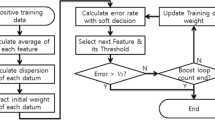Abstract
Method of fuzzy boosting providing iterative weak classifiers selection and their quasi-linear composition construction is presented. The method is based on the combination of boosting and fuzzy integrating techniques, when at each step of boosting weak classifiers are combined by Choquet fuzzy integral. In the proposed FuzzyBoost algorithm 2-additive fuzzy measures were used, and method for their estimation was proposed. Although detailed theoretical verification of proposed algorithm is still absent, the experimental results, made on simulated data models, demonstrate that in the case of complex decision boundaries FuzzyBoost significantly outperforms AdaBoost.
Similar content being viewed by others
References
L. A. Rasstrigin and R. H. Ehrenstein, Method of Collective Recognition (Energoizdat, Moscow, 1981) [in Russian].
Y. L. Barabash, Collective Statistical Decisions in Recognition (Radio i svyaz’, Moscow, 1983) [in Russian].
T. K. Ho, “Multiple classifier combination: lessons and the next steps,” in Hybrid Methods in Pattern Recognition (World Sci. Publ., 2002), pp. 171–198.
L. I. Kuncheva, Combining Pattern Classifiers: Methods and Algorithms (John Wiley & Sons, 2004).
J. Ghosh, “Multiclassifier systems: back to the future,” Lecture Notice Comput. Sci. 2364, 1–15 (2002).
Handbook of Face Recognition, Ed. By S. Z. Li and A. K. Jain (Springer Sci.+Business Media, 2005).
J. Friedman, T. Hastie, and R. Tibshirani, “Additive logistic regression: a statistical view of boosting,” Ann. Stat. 38 2, 337–374 (2000).
M. Grabisch and Ch. Labreuche, “A decade of application of the Choquet and Sugeno integrals in multi-criteria decision aid,” Quarterly J. Operat. Res. 6 1, 1–44 (2008).
L. I. Kuncheva, ““Fuzzy” versus “nonfuzzy” in combining classifiers designed by boosting,” IEEE Trans. Fuzzy Syst. 11 6, 729–741 (2003).
L. Junco and L. Sanchez, “Using the Adaboost algorithm to induce fuzzy rules in classification problems,” in Proc. ESTYLF (Sevilla, 2000), pp. 297–301.
M. J. Del Jesus, F. Hoffmann, J. L. Navascues, and L. Sanchez, “Induction of fuzzy rule based classifiers with evolutionary boosting algorithms,” IEEE Trans. Fuzzy Sets Syst. 12 3, 296–208 (2004).
A. V. Samorodov, “Application of a fuzzy integral for weak classifiers boosting,” Pattern Recogn. Image Anal. 21 2, 206–210 (2011).
M. Grabisch and J.-M. Nicolas, “Classification by fuzzy integral: performance and tests,” Fuzzy Sets Syst. 65, 255–271 (1994).
M. Grabish, “k-order additive discrete fuzzy measures and their representation,” Fuzzy Sets Syst. 92, 167–189 (1997).
L. Mikenina and H.-J. Zimmermann, “Improved feature selection and classification by the 2-additive fuzzy measure,” Fuzzy Sets Syst. 107, 197–218 (1999).
M. Grabish and C. Labreuche, “The Choquet integral for 2-additive bi-capacities,” in Proc. 3rd Int. Conf. of the European Soc. for Fuzzy Logic and Technology (EUSFLAT 2003) (Zittau, 2003), pp. 300–303.
Author information
Authors and Affiliations
Corresponding author
Additional information
This paper uses the materials of the report submitted at the 9th Open German-Russian Workshop on Pattern Recognition and Image Understanding, held in Koblenz, December 1–5, 2014 (OGRW-9-2014).
The article published in the original.
Samorodov Andrey Vladimirovich born on November 19, 1975. Graduated from Bauman Moscow State Technical University in 1999. Received candidate (PhD) degree in engineering sciences at Bauman Moscow State Technical University in 2002. Associate professor, Chair for Biomedical Technical Systems, Bauman Moscow State Technical University. Fields of research priorities:
Methods and algorithms of pattern recognition and multi-classification
Automated microscopy of biomedical preparations
Computer-aided decision-making systems in medicine
Methods and technique for biomedical images and signals recognition
Author of more than 200 scientific publications (including 1 collective monograph and more than 30 journal papers).
Rights and permissions
About this article
Cite this article
Samorodov, A.V. Method of weak classifiers fuzzy boosting: Iterative learning of quasi-linear algorithmic composition. Pattern Recognit. Image Anal. 26, 266–273 (2016). https://doi.org/10.1134/S105466181602019X
Received:
Published:
Issue Date:
DOI: https://doi.org/10.1134/S105466181602019X




